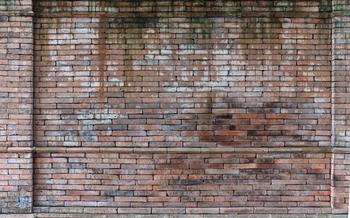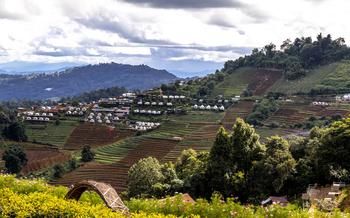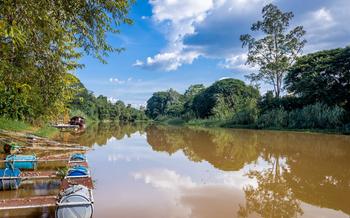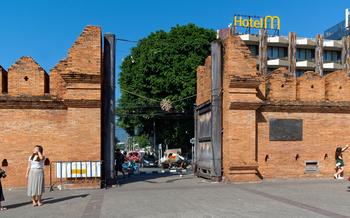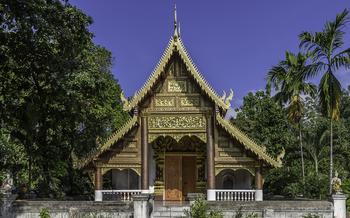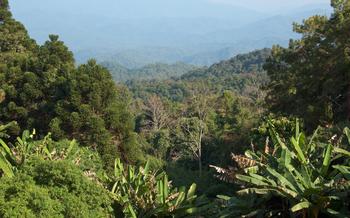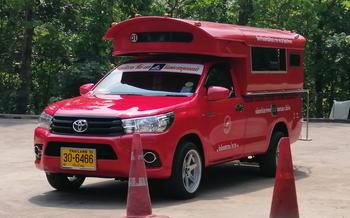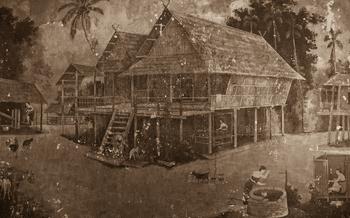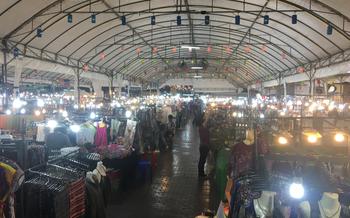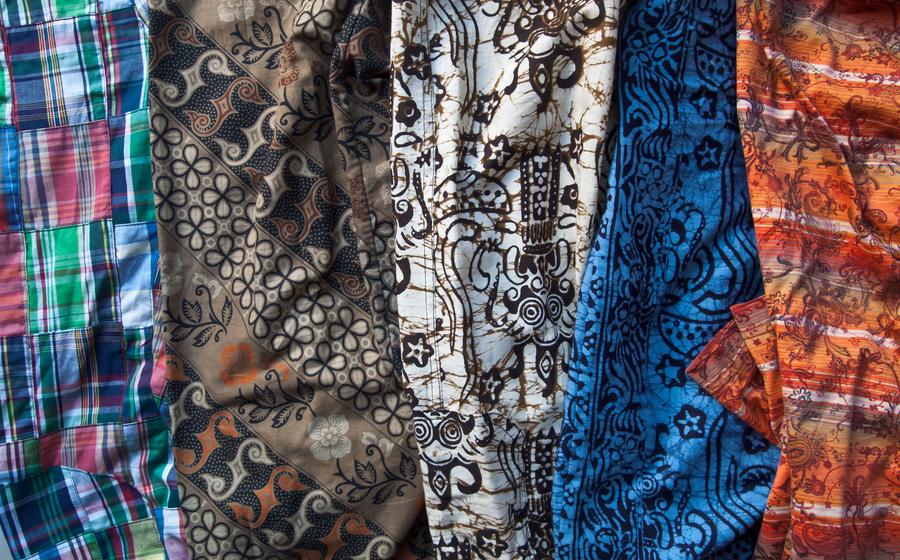
Mae Ping River Cruise
- Mae Ping River Cruise: A Relaxing Journey Through Chiang Mai's Waterways
- Exploring the Riverside Temples
- Floating Markets: A Unique Shopping Experience
- Location and Accessibility:
- Goods and Souvenirs:
- Bargaining:
- Local Delicacies:
- Wat Chiang Man: A Haven of Tranquility
- Wat Phra Singh: A Masterpiece of Lanna Architecture
- Chiang Mai Night Bazaar: A Shopaholic's Paradise
- Elephant Nature Park: A Sanctuary for Gentle Giants
- Doi Suthep-Pui National Park: A Scenic Escape
- Location and Accessibility
- Hiking Trails and Natural Wonders
- Stunning Views from the Summit of Doi Suthep
- Tips for a Safe and Enjoyable Hiking Experience
- Khantoke Dinner: A Taste of Northern Thai Cuisine
- Chiang Mai Zoo: Wildlife Encounters and Conservation
- Chiang Mai Art and Cultural Center: A Creative Hub
- Bhubing Palace: A Royal Retreat
- Insider Tips:
- Wat Sri Suphan: The Silver Temple
- Insider Tip: Exploring the Hidden Gems of Chiang Mai
Mae Ping River Cruise: A Relaxing Journey Through Chiang Mai's Waterways
The Mae Ping River, the lifeblood of Chiang Mai, winds its way through the heart of the city, offering a unique perspective on this vibrant and culturally rich destination. A Mae Ping River Cruise is an enchanting way to experience the city's history, culture, and natural beauty.
The river has played a pivotal role in Chiang Mai's development, serving as a vital trade route and a source of water and sustenance for centuries. Today, it remains an integral part of the city's fabric, with bustling markets, ancient temples, and lush greenery lining its banks.
There are several types of cruises available, catering to different preferences and budgets. Visitors can choose from leisurely sightseeing cruises, which offer panoramic views of the city's landmarks, to more adventurous options like sunset cruises or dinner cruises, providing a truly memorable experience.
Duration and Prices:
The duration of the cruises varies, ranging from one hour to several hours, depending on the route and the type of cruise chosen. Prices typically start from around 200 baht for a basic sightseeing cruise and can go up to 1,000 baht or more for a premium dinner cruise with live entertainment.
Best Time to Visit:
The best time to visit Chiang Mai for an optimal river cruise experience is during the cooler months from November to February when the weather is pleasant and the skies are clear. During this time, the river levels are also at their highest, making for a smoother and more scenic journey.
Exploring the Riverside Temples
As you embark on the Mae Ping River Cruise, you'll encounter a series of magnificent temples perched along the riverbanks, inviting you to delve into Chiang Mai's rich cultural and religious heritage. These temples not only serve as significant spiritual landmarks but also offer stunning architectural wonders that showcase the artistry and craftsmanship of the Lanna Kingdom.
Among the most renowned temples is Wat Chiang Man, the oldest temple in Chiang Mai, boasting a serene atmosphere and exquisite Lanna-style architecture. Wat Phra Singh, with its intricate murals and revered Buddha images, is another must-visit site, showcasing the grandeur of Lanna artistry. For a glimpse of a majestic stupa, explore Wat Chedi Luang, whose impressive ruins and panoramic views make it a captivating destination.
As you visit these riverside temples, embrace the opportunity to learn about their historical significance, delve into their unique architectural features, and pay homage to the sacred Buddha images enshrined within. Remember to observe respectful temple etiquette, including dressing appropriately, removing your shoes before entering, and refraining from touching any religious objects.
Floating Markets: A Unique Shopping Experience
Nestled along the picturesque canals of Chiang Mai, the floating markets offer a vibrant tapestry of colors, sounds, and flavors. Take a leisurely boat ride or hop from one vendor to another on foot, immersing yourself in a unique shopping experience that's quintessentially Thai.
Location and Accessibility:
The most famous floating markets in Chiang Mai are the Mae Kha Canal Market and the Ton Lamyai Market. These markets are located just outside the city center, easily accessible by tuk-tuk or songthaew (shared taxi).
Goods and Souvenirs:
From fresh produce and local delicacies to handmade crafts and souvenirs, the floating markets have it all. Browse through an array of tropical fruits, colorful flowers, traditional Thai clothing, and unique handicrafts that make for memorable take-home gifts.
Bargaining:
Bargaining is an essential part of the floating market experience. Start with a fair offer and be prepared to negotiate; it's all part of the fun. Don't be afraid to walk away if you're not satisfied with the price—there are plenty of other vendors to choose from.
Local Delicacies:
Indulge in a culinary adventure at the floating markets. Sample delicious local delicacies such as khao soi (northern Thai curry noodles), sai ua (northern Thai sausage), and khanom jeen nam ngiao (rice noodles with fermented pork curry). Don't forget to try the freshly squeezed fruit juices and sweet treats like khao niew mamuang (mango sticky rice) for a refreshing treat.
Wat Chiang Man: A Haven of Tranquility
Wat Chiang Man, the oldest and most revered temple in Chiang Mai, holds a special place in the hearts of locals and visitors alike. Built in 1296 by King Mengrai, the temple is a testament to the city's rich history and cultural heritage.
Historical Significance: Wat Chiang Man is not just the oldest temple in Chiang Mai but also the birthplace of the city itself. According to legend, King Mengrai, the founder of the Lanna Kingdom, chose this site after observing an auspicious sign involving a white elephant. The temple's location, at the confluence of the Ping River and the Mae Rim River, was strategically significant, making it a center of trade and commerce.
Architectural Features and Highlights: Wat Chiang Man boasts a unique blend of Lanna and Burmese architectural styles. The temple's most striking feature is its large, stepped stupa, which is covered in intricately carved tiles depicting scenes from the Jataka tales. The viharn, or main assembly hall, houses a revered Buddha image known as Phra Sila, which is believed to have been created in the 9th century.
Buddha Images and Sacred Relics: Wat Chiang Man is home to several important Buddha images, including Phra Sila, which is considered one of the most sacred Buddha images in Thailand. The temple also houses the Emerald Buddha for a brief period before it was moved to Wat Phra Kaew in Bangkok.
Tips for Creating a Serene and Meaningful Visit: To fully appreciate the serenity and spiritual significance of Wat Chiang Man, it is advisable to visit early in the morning or late in the afternoon when the crowds are smaller. Remember to dress respectfully and remove your shoes before entering the temple. Take some time to sit in meditation or simply soak in the peaceful atmosphere of this ancient temple.
Wat Phra Singh: A Masterpiece of Lanna Architecture
Wat Phra Singh is a stunning Buddhist temple located in the heart of Chiang Mai, renowned for its exquisite Lanna-style architecture and religious significance. Built in the 14th century, the temple has undergone several renovations and expansions over the years, resulting in a harmonious blend of traditional and modern elements.
The temple's most striking feature is its intricate Lanna-style architecture, characterized by graceful curves, delicate carvings, and ornate stupas. The main viharn, or assembly hall, houses a revered Buddha image known as Phra Phuttha Sihing, which is believed to date back to the 9th century. The image is adorned with gold leaf and precious gems, exuding an aura of serenity and spirituality.
Wat Phra Singh is also home to a collection of impressive murals depicting scenes from the life of Buddha and various Jataka tales. These murals, created by skilled artisans over several centuries, offer a glimpse into the rich cultural and religious heritage of the Lanna Kingdom.
To fully appreciate the beauty of Wat Phra Singh, take some time to explore the temple grounds. Admire the intricate carvings on the chedis, or stupas, and the delicate Lanna-style architecture of the various buildings. The temple also features a beautiful courtyard with lush gardens, providing a tranquil oasis amidst the bustling city.
Tips for capturing the best photos of Wat Phra Singh:
- Visit the temple early in the morning or late in the afternoon to avoid harsh sunlight and capture the best light for photography.
- Use a wide-angle lens to capture the temple's grand facade and the surrounding courtyard.
- Experiment with different angles and perspectives to create unique and interesting compositions.
- Look for details such as the intricate carvings on the chedis and the colorful murals in the viharn.
- If possible, visit the temple during a festival or special event to capture the vibrant atmosphere and colorful decorations.
Chiang Mai Night Bazaar: A Shopaholic's Paradise
Nestled in the heart of Chiang Mai, the Night Bazaar is a vibrant and bustling market that comes alive as the sun sets. With its labyrinthine alleys and countless stalls, it's a shopper's paradise where you can find everything from handmade crafts and souvenirs to trendy fashion and local delicacies.
The Night Bazaar is easily accessible, located within walking distance of many hotels and guesthouses in the city center. As you wander through the market, you'll be amazed by the sheer variety of goods on offer. From colorful hill tribe textiles and intricate silver jewelry to hand-painted ceramics and quirky souvenirs, there's something to suit every taste and budget.
Bargaining is an essential part of the shopping experience in Thailand, and the Night Bazaar is no exception. Don't be afraid to haggle with the vendors to get the best possible price. However, always be respectful and remember that the vendors are making a living, so don't be too aggressive.
Navigating the crowds can be a challenge, especially during peak tourist season. It's best to visit the Night Bazaar on a weekday or early in the evening to avoid the worst of the crowds. If you're looking for unique and authentic items, be sure to explore the smaller alleys and side streets, where you'll find hidden gems that the majority of tourists miss.
The Night Bazaar is more than just a shopping destination; it's also a great place to experience the vibrant energy of Chiang Mai. As you wander through the market, you'll be surrounded by the sounds of live music, the smell of delicious street food, and the friendly smiles of the local vendors. It's a truly immersive experience that will leave you with lasting memories of your time in Chiang Mai.
Elephant Nature Park: A Sanctuary for Gentle Giants
Nestled amidst the lush forests of Chiang Mai, Elephant Nature Park stands as a beacon of hope for these majestic creatures. Founded on the principles of compassion and conservation, this ethical sanctuary provides a safe haven for rescued elephants, offering them a chance to heal, roam freely, and live out their lives with dignity.
As you step into the park, you'll be greeted by the heartwarming sight of elephants grazing peacefully in open fields, taking mud baths, or interacting playfully with each other. The park's philosophy centers around providing a natural and stress-free environment, allowing the elephants to regain their physical and emotional well-being.
Visitors to Elephant Nature Park have the opportunity to engage in meaningful interactions with these gentle giants. You can observe them up close, learn about their individual stories, and witness their remarkable intelligence and social bonds. Ethical elephant trekking is available, where you can embark on a leisurely walk alongside these majestic creatures, accompanied by experienced guides who ensure their safety and comfort.
Beyond elephant encounters, the park also plays a crucial role in conservation efforts. It actively participates in research and education programs, raising awareness about the plight of elephants in Thailand and the importance of protecting their natural habitats. By visiting Elephant Nature Park, you not only contribute to the well-being of these magnificent animals but also support vital conservation initiatives.
To ensure a memorable and ethical experience, remember to book your visit in advance, as spaces are limited. Choose a reputable tour operator that prioritizes animal welfare and follows responsible tourism practices. When interacting with the elephants, always maintain a respectful distance and avoid touching or riding them. Instead, observe their natural behaviors and learn from the knowledgeable guides who can provide insights into their unique characteristics and personalities.
Your visit to Elephant Nature Park will not only create lasting memories but also contribute to the preservation of these incredible creatures and their natural habitats. It's an experience that will leave you with a deep appreciation for the beauty and majesty of elephants while inspiring you to become an advocate for their well-being.
Doi Suthep-Pui National Park: A Scenic Escape
Nestled just a short distance from Chiang Mai's bustling city center, Doi Suthep-Pui National Park offers a refreshing escape into nature's embrace. Encompassing over 260 square kilometers of lush forests, rolling hills, and cascading waterfalls, the park is a haven for nature enthusiasts, hikers, and adventure seekers.
Location and Accessibility
Doi Suthep-Pui National Park is conveniently located just 15 kilometers west of Chiang Mai. Visitors can easily reach the park by taking a songthaew (shared taxi) or renting a motorbike from the city. The park entrance is situated near the base of Doi Suthep, the highest peak in the park.
Hiking Trails and Natural Wonders
The park boasts an extensive network of well-maintained hiking trails, catering to hikers of all levels. From leisurely strolls along the Mae Ping River to challenging ascents to the summit of Doi Suthep, there's a trail for every preference. Along the way, hikers will encounter stunning waterfalls, panoramic viewpoints, and a diverse array of flora and fauna.
Stunning Views from the Summit of Doi Suthep
The highlight of the park is undoubtedly the summit of Doi Suthep, which offers unparalleled views of Chiang Mai and the surrounding countryside. The climb to the summit is strenuous but rewarding, taking hikers through lush forests and past ancient temples. At the peak, visitors are greeted with a breathtaking panorama that stretches for miles in every direction.
Tips for a Safe and Enjoyable Hiking Experience
To ensure a safe and enjoyable hiking experience in Doi Suthep-Pui National Park, it is advisable to come prepared. Wear comfortable shoes, bring plenty of water and snacks, and consider using trekking poles for added stability. It is also essential to be aware of the park's wildlife, including wild elephants and snakes. If hiking alone, it is advisable to inform someone of your itinerary and expected return time.
Khantoke Dinner: A Taste of Northern Thai Cuisine
Indulge in a captivating culinary journey with a traditional Lanna-style Khantoke dinner. This unique dining experience transports you to the heart of Northern Thai culture, where you'll savor authentic dishes and witness enchanting performances that showcase the region's rich heritage.
As you settle into the communal seating arrangement, an array of mouthwatering delicacies awaits you. From the iconic khao soi, a coconut-based noodle soup, to the flavorful sai ua, a grilled sausage, each dish bursts with the distinct flavors of Northern Thailand. Accompanied by sticky rice, fresh vegetables, and a variety of dipping sauces, the Khantoke feast is a symphony of textures and tastes.
While you relish the culinary delights, be captivated by the mesmerizing performances that accompany your meal. Traditional Lanna dances, with their graceful movements and colorful costumes, tell stories of ancient legends and folklore. The rhythmic beats of traditional music, played on instruments like the khene, a bamboo mouth organ, and the khaen, a bamboo xylophone, create a lively and enchanting atmosphere.
To fully immerse yourself in the Khantoke experience, embrace the local customs and traditions. Show your respect by removing your shoes before entering the dining area and adopt the traditional seating position, which involves sitting on a mat with your legs crossed. Be prepared to engage with your fellow diners, as sharing food and conversation is an integral part of the Khantoke ritual.
To ensure a memorable Khantoke experience, choose a reputable restaurant that offers authentic Lanna cuisine and cultural performances. Research local recommendations, read online reviews, and ask your hotel concierge for advice. Remember to book your reservation in advance, especially during peak tourist seasons, to secure a spot at this sought-after dining experience.
Chiang Mai Zoo: Wildlife Encounters and Conservation
Chiang Mai Zoo is a captivating destination for wildlife enthusiasts, offering a diverse range of animal species and habitats. Embark on a journey to encounter majestic creatures from around the world, while simultaneously supporting conservation and breeding programs that contribute to the preservation of endangered species.
-
Animal Encounters: Witness over 7,000 animals representing 700 different species, including iconic elephants, playful pandas, ferocious tigers, and graceful giraffes. Observe their fascinating behaviors and learn about their unique adaptations.
-
Conservation Initiatives: The zoo actively participates in conservation and breeding programs, playing a crucial role in protecting endangered species and contributing to their reintroduction into their natural habitats. Visitors can learn about these initiatives and the importance of wildlife conservation.
-
Educational Experiences: Chiang Mai Zoo offers educational programs and interactive exhibits to enhance visitors' understanding of the animal kingdom. Engage in hands-on activities, attend informative talks, and participate in wildlife workshops to deepen your knowledge and appreciation for the natural world.
-
Must-See Highlights: Don't miss the impressive elephant enclosure, where you can witness these gentle giants interact and enjoy their daily mud bath. Observe the playful antics of the pandas as they munch on bamboo and climb trees. Encounter the awe-inspiring tigers in their naturalistic habitat, showcasing their strength and agility. Marvel at the graceful giraffes as they tower over the landscape.
-
Tips for a Responsible Visit: To ensure a responsible and educational experience, remember to respect the animals by maintaining a safe distance and avoiding flash photography. Support the zoo's conservation efforts by participating in educational programs and donating to their initiatives. Follow zoo guidelines to minimize disturbance to the animals and their habitats.
Chiang Mai Art and Cultural Center: A Creative Hub
Nestled in the heart of Chiang Mai, the Chiang Mai Art and Cultural Center stands as a vibrant hub for local and contemporary art. This cultural institution offers a diverse range of exhibitions, workshops, and performances that celebrate the rich artistic traditions of Northern Thailand.
Exhibitions and Workshops:
The center hosts a variety of art exhibitions throughout the year, showcasing the works of both established and emerging artists from the region. These exhibitions cover a wide spectrum of mediums, including painting, sculpture, photography, and mixed media. Alongside the exhibitions, the center also conducts workshops and classes, providing visitors with an opportunity to learn from local artists and immerse themselves in the creative process.
Historical and Contemporary Art Collections:
The center's permanent collection features a diverse range of historical and contemporary artworks that reflect the cultural heritage and artistic evolution of Northern Thailand. Visitors can admire traditional Lanna-style paintings, intricate wood carvings, and contemporary installations that explore modern themes and issues.
Traditional Crafts and Performances:
The center also serves as a platform for traditional crafts and performances. Visitors can witness skilled artisans demonstrating their mastery in weaving, pottery, and other traditional crafts. Additionally, the center hosts regular performances of Lanna classical dance, music, and theater, providing a glimpse into the rich cultural traditions of the region.
Tips for Planning a Visit:
- Check the center's website or social media pages for upcoming exhibitions, workshops, and events.
- Plan your visit to coincide with one of the center's regular cultural performances or demonstrations.
- Take advantage of the center's guided tours, which offer insights into the artworks and cultural significance of the exhibits.
- Allow ample time to explore the center's various galleries and exhibitions, as well as the surrounding grounds.
Bhubing Palace: A Royal Retreat
Nestled atop Doi Bhubing, a mountain overlooking Chiang Mai, lies the enchanting Bhubing Palace. This former summer residence of the royal family is steeped in history and offers visitors a glimpse into Thailand's regal past.
Built in the early 20th century as a retreat for the royal family to escape the sweltering summer heat, Bhubing Palace showcases a blend of traditional Lanna and European architectural styles. Visitors can admire the intricate woodwork, colorful murals, and manicured gardens that create a serene and picturesque setting.
The palace grounds also boast stunning panoramic views of Chiang Mai and its surroundings. On a clear day, visitors can see the distant peaks of the Doi Suthep mountain range and the lush green valleys that embrace the city.
To fully appreciate the grandeur of Bhubing Palace, plan your visit during special events or festivals, when the palace comes alive with vibrant performances, traditional ceremonies, and cultural exhibitions. These events provide a unique opportunity to immerse yourself in the rich heritage and traditions of Northern Thailand.
Insider Tips:
- Check the official website of Bhubing Palace for information on upcoming events and festivals.
- If visiting during the summer months, remember to bring along sunscreen, sunglasses, and a hat to protect yourself from the strong sun.
- The palace is located approximately 15 kilometers from Chiang Mai city center. Consider renting a motorbike or hiring a local guide to navigate the winding mountain roads.
- For a truly immersive experience, opt for a guided tour that delves into the history, architecture, and cultural significance of Bhubing Palace.
Wat Sri Suphan: The Silver Temple
Nestled in the heart of Chiang Mai's Old City, Wat Sri Suphan, also known as the Silver Temple, is a unique and awe-inspiring sight to behold. Constructed entirely of silver, this remarkable temple stands as a testament to the artistry and craftsmanship of the Lanna people.
The temple's exterior is adorned with intricate silver artwork and decorations, creating a mesmerizing spectacle that shimmers in the sunlight. The main chedi, or stupa, is particularly impressive, with its silver-plated spires reaching towards the sky.
Inside the temple, visitors can admire the silver Buddha images and other religious artifacts, all of which are beautifully crafted with meticulous attention to detail. The walls are adorned with intricate murals depicting scenes from Buddhist mythology, adding to the temple's sacred and serene atmosphere.
Wat Sri Suphan is a relatively new temple, having been completed in 2004, but it has quickly become a popular destination for both locals and tourists alike. It is a unique and unforgettable experience to visit this stunning temple and marvel at the artistry and craftsmanship that went into its creation.
Tips for Capturing the Best Photos of the Temple's Exterior:
- Visit during the early morning or late afternoon to avoid harsh lighting.
- Use a wide-angle lens to capture the temple's grandeur and intricate details.
- Experiment with different angles and perspectives to create unique and dynamic shots.
- Consider using a tripod for stability and to capture sharp images.
- Don't forget to capture the surrounding environment, including the lush gardens and traditional Lanna-style buildings.
Insider Tip: Exploring the Hidden Gems of Chiang Mai
Beyond the popular tourist attractions, Chiang Mai offers a wealth of hidden gems waiting to be discovered. Venture off the beaten path and uncover secret temples nestled amidst lush greenery, vibrant local markets brimming with authentic treasures, and unique experiences that showcase the city's rich culture and heritage.
For an insider's perspective, consider hiring a local guide or joining a small-group tour that specializes in exploring Chiang Mai's hidden gems. These guides can provide valuable insights into the city's history, customs, and traditions, ensuring a more immersive and meaningful experience.
To fully embrace the local culture, immerse yourself in the bustling atmosphere of local markets. Visit Warorot Market, a labyrinth of stalls selling everything from fresh produce to handmade crafts, or explore the colorful umbrella market, where you can find an array of handmade umbrellas in vibrant hues.
For a spiritual journey, seek out lesser-known temples such as Wat Umong, a forest monastery with a network of tunnels and meditation caves, or Wat Pha Lat, a serene temple nestled amidst limestone cliffs. These hidden gems offer a tranquil escape from the city's hustle and bustle, allowing you to connect with your inner self and delve deeper into Chiang Mai's rich spiritual heritage.
Embrace the opportunity to explore independently and discover your own hidden gems. Rent a bicycle or motorbike and embark on a leisurely journey through the city's backstreets and alleyways. Keep your eyes peeled for charming cafes, independent art galleries, and hidden courtyards that reveal the true essence of Chiang Mai's vibrant culture.
For an unforgettable experience, plan your visit during one of Chiang Mai's many festivals or events. From the colorful Songkran Water Festival to the vibrant Lanna cultural festival, these events offer a unique glimpse into the city's rich traditions and provide a platform for local communities to showcase their heritage through music, dance, and traditional performances.
To enhance your exploration, consider utilizing helpful resources such as guidebooks, online forums, and travel blogs. These sources can provide valuable recommendations and tips for discovering hidden gems, ensuring a truly immersive and enriching experience in Chiang Mai.
